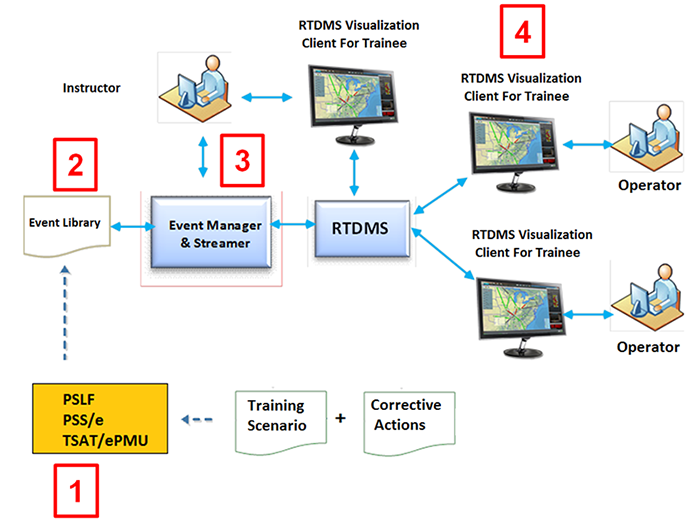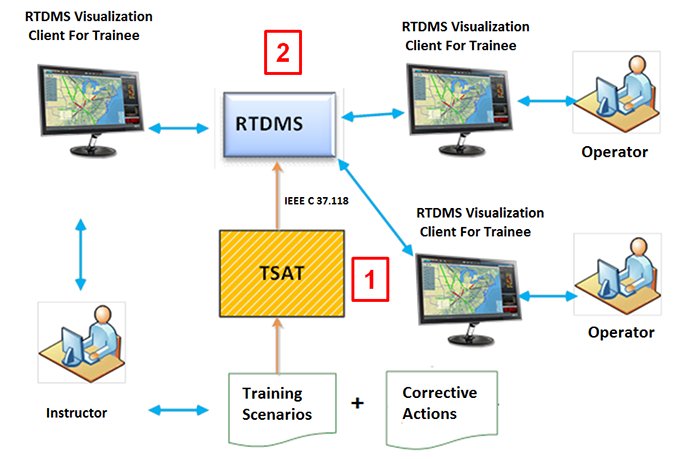Advances in measurement, communications and computing technology have now made it feasible and practical for largescale use of synchrophasor technology for real-time operations. Monitoring, Visualization, analysis and application based on high-speed, streaming phasor data is significantly different and advanced from traditional EMS systems which is based on snapshots of power metrics of a localized footprint. Adoption and use in real time operations requires training – fundamentals, theory and hands-on exercises.
Training requires time and resources. To address this need, EPG has developed a web based online training portal providing courses on synchrophasor technology which can be taken on demand, anytime, anywhere that internet access is available. The courses are developed to train engineers, planners, operators and others on synchrophasors and their use in operations. The web portal is designed for authorized users only and the courses include lectures, presentation slides, videos and interactive quizzes. The web training portal provides:
- Online Training Courses on synchrophasor technology
- Freedom to take courses online anywhere, anytime and from any device with just internet access
- Ability to take the courses any number of times and repeated for shift engineers and operators to refresh their knowledge
- Flexibility to add more training courses that are customized
Course Information & Enrollment:
For Individual Enrollment, download the brochure and enrollment form below. Individuals may obtain a 1 year enrollment to the "Introduction to Synchrophasors" course upon payment of $1,500 per person. Please complete the enrollment form and send it back to EPG.
For Corporate Subscription involving multiple users, or an evaluation account, please contact Ajay Das.
Phone: 626-685-2015 ext. 128
“Introduction to Synchrophasors” Course:
“Introduction to Synchrophasors” provides an essential primer on synchrophasor (or phasor) technology. The course covers essential aspects of this technology – what is measured, the various components, terminology, concepts, advantages and uses.
The course provides a well-rounded understanding of synchrophasors. It consists of 5 sessions each focusing on a key area of synchrophasors, and together, the 5 sessions form a strong foundational understanding and awareness of the domain. Each session is of approximately 1 hr. of instruction. They are:
-
Synchrophasors Fundamentals (Instructor: Ken Martin)
This session provides an introduction to synchrophasors and covers the following topics:
- 1. Phasors - Fundamentals
- 2. Synchrophasors - Definition and Description
- 3. Synchrophasor Attributes - Essential Properties
- 4. Applying Synchrophasors - Measurement Principles and Examples
- 5. Synchrophasor Technology Infrastructure - Components and Data Flow
A preview of this session is available here.
-
Synchrophasor Metrics - Use in Real-time Operations (Instructor: Wayne Schmus)
This session describes synchrophasor metrics and explains how these metrics can be used in real time operations. The topics covered in this session are given below:
- 1. Introduction to Synchrophasor Metrics
- 2. Phase Angle Differences - How to use phase angle differences to assess grid stress?
- 3. Voltage Sensitivity - How to use voltage sensitivities to assess voltage stability
- 4. Frequency Deviations ‐ How to use frequency deviations to assess grid disturbances and instability?
- 5. Oscillations - How to use synchrophasors to assess the risk posed by oscillations?
A preview of this session is available here.
-
Phase Angle Differences – How Can They Be Used in Operations? (Instructor: Jim Dyer)
This session describes phase angle differences and explains how they can be used in real time operations. The topics covered in this session are given below:
- 1. Definition & Importance of Phase Angle Differences for Operations
- 2. Phase Angle Differences – What are safe values?
- 3. Importance of PMU Location
- 4. Use of Phase Angles in Control Rooms - Line Closing
- 5. Case Study – 8 Bus System
- 6. Use of Phase Angles in Control Rooms - Islanding & System Separation
- 7. Phasor Assisted Line Reclosing
A preview of this session is available here.
-
Grid Event Signatures - Use in Operations to Detect & Diagnose Grid Events (Instructor: Prashant Palayam)
This session describes different types of grid events and their signatures. The topics covered in this session are given below:
- 1. Introduction to Grid Event Signatures
- 2. Types of Grid Event Signatures - Generation Trip, Line Fault, Line Trip, Load Trip, Islanding, Oscillations
- 3. Identify Event Type Using System Frequency Signature
- 4. Event Diagnosis - Using Synchrophasor Metrics
- 5. Corrective Action and Validation Using Signatures
- 6. Case Study – Generation Trip and Line Trip
A preview of this session is available here.
-
Power System Oscillations - Types, Causes & Monitoring (Instructor: Kevin Chen)
This session describes power system oscillations and how to detect and monitor oscillations in the power grid. The topics covered in this session are given below:
- 1. Introduction to Power System Oscillations
- a. What are oscillations?
- b. Why are oscillations important?
- c. Characteristics of Oscillations - Frequency, Damping, Amplitude & Phase
- d. Types of Oscillations
- 2. Identifying and Analyzing Oscillations
- 3. Oscillation Monitoring
- 4. Oscillation Detection
- 5. Use Cases
- a. Inter-area oscillation
- b. Wind power plant forced oscillation
A preview of this session is available here.
 EPG’s synchrophasor solutions are in use at over 50 organizations in North America helping reliability operations across all three interconnections (WECC, EI and ERCOT).
EPG’s synchrophasor solutions are in use at over 50 organizations in North America helping reliability operations across all three interconnections (WECC, EI and ERCOT).




